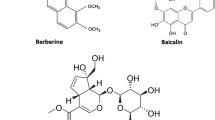Summary
Panax notoginseng is used as a therapeutic agent in Chinese medicine for stopping hemorrhage and also as a general health remedy. AlthoughPanax notoginseng saponins (PNS) are currently attracting attention due to their hemorheological properties, the absorption profiles of PNS have still not been fully investigated. In the present study, an in situ intestinal perfusion rat model was used to investigate the absorption mechanism of sanchinoside R1 (R1) and ginsenoside Rg1 (Rg1), two main components of PNS. Quantitative analysis methods for R1 and Rg1 were first established, then concentrations of R1 and Rg1 in the perfusate were measured in real time through assessment of circulating perfusate in the rat small intestine. The absorption rate constant (ka) values for R1 were 0.1223,0.0946 and 0.0904 h−1 at a dose of 1, 10 and 100 mg respectively, while those of Rg1 were 0.1169, 0.1134 and 0.1089 h−1 at a dose of 1, 10 and 100 mg respectively. The optimal absorption site for both of these compounds was found to be the duodenum, which indicated that the bioavailability of the orally administered PNS preparation was relatively low. Finally, the effect of certain absorption promoters on the absorption rates of R1 and Rg1 was investigated. It was found that carbomer and borneol could enhance the permeability of R1 and Rg1 on the intestinal wall (P<0.05), which indicated that a suitable absorption promoter could improve the absorption of PNS and increase its bioavailability.
Similar content being viewed by others
References
Cicero AFG, Bandieri E, Arletti R (2000): Orally administered Panax notoginseng influence on rat spontaneous behavior. J Ethnopharmacol 73:387–391.
Han JA, Hu WY, Sun ZH (1999): Effect of Panax notoginseng saponin on Ca2+, CaM in craniocerebral injury. Chin J Integr Trad Western Med 19(4):227–229.
Wei Guang MA, Mizutani M, et al. (1999): Saponins from the roots of Panax notoginseng. Phytochemistry 52:1133–1139.
Csacy TZ (1994): {bcIntestinal permeation and permeability: an overview}. In: Pharmacology of intestinal permeation. I. Springer-Verlag, New York, pp. 51–59.
Fleisher D, Sheth N, Griffin H, et al. (1999): Nutrient influence on rat intestinal Phenytoin uptake. Pharm Res 6:332–336.
Riad LE, Sawchuke RJ (1991): Absorptive clearance of carbamazepine and selected metabolites in rabbit intestine. Pharmacol Res 8:1050–1055.
Ochsenfahrt H, Winne D The contribution of solvent drag to the intestinal absorption of the acidic drug benzoic acid and salicylic acid from the jejunum of the rat. Naunyn Schmiedebergs Arch Pharmakol 281:192–217.
Hayashi M, SawadaT, Tomita M (1990): Significance of the paracellular pathway in intestinal drug absorption. Eur J Drug Metab Pharmacokinet p. 408.
Andlauer W, Kolb J (2000): Absorption and metabolism of genistin in the isolated rat small intestine. FEBS Lett 475:127–130.
Wacher VJ, Silverman A, Zhang Y, Benet LZ (1998): Role of P-glycoprotein and cytochrome P450 3A in limiting oral absorption of peptide and peptidomimetics. J Pharm Sei 87:1322–1330.
Ambudkar SV, Dey S, Hrycyna CA, Ramachandra M, Pastan I, Gottesman MM (1999) Biochemical, cellular, and pharmacological aspects of the multidrug transporter. Annu Rev Pharmacol Toxicol 39: 361–368.
Barthe L, Woodley J, Houin G (1999): Gastrointestinal absorption of drugs: methods and studies. Fundam Clin Pharmacol 13:154–168.
Yuasa H, Matsuda K, Watanabe J (1993): Influence of anesthetic regents on intestinal absorption in rats. Pharm Res 10:884–888.
Bleske BE, Welage LS, Rose S (1995): J Clin Pharmacol 35:374.
Menzies IM (1983): Transmucosal passage of inert molecules in health and disease. In: Skadhauge E, Heintze K, Eds. Intestinal absorption and secretion. MTP Press, Lancaster, PA, pp. 527–543.
Nerurkar MM, Urton PS, Borchardt RT (1996): The use of surfactants to enhance permeability of peptides through Caco-2 cells by inhibition of an apically polarized efflux system. Pharm Res 13:528–534.
Author information
Authors and Affiliations
Rights and permissions
About this article
Cite this article
Liang, F., Hua, J.X. Absorption profiles of sanchinoside R1 and ginsenoside Rg1 in the rat intestine. European Journal of Drug Metabolism and Pharmacokinetics 30, 261–268 (2005). https://doi.org/10.1007/BF03190630
Received:
Issue Date:
DOI: https://doi.org/10.1007/BF03190630




